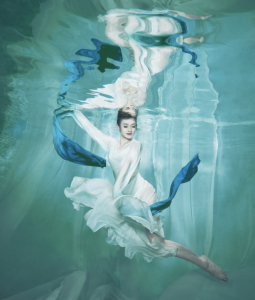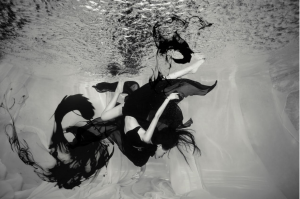
One day whilst I was swimming in a pool, the waves coming from another swimmer nearby caused my body to involuntarily move up and down with the current. It was in that moment that I really felt inspired. I started to imagine just how interesting it would be if I could dance underwater. That is how my exploration into the captivating world of underwater dance began.
What Makes Underwater Movement so Fascinating?
The first reason for the fascination with for this art form is connected to our environment and the circumstances in which we as dancers habitually move. As dancers we are used to moving in a specialised space, such as a rehearsal room or a theatre, which has professional flooring and electronic equipment. However, this kind of space has not been available to many of us during the long period of COVID-19 lockdown. Thus, I started to bring my dance practice to new and different environments, such as my sitting room and even outdoors. It was during this process that I became interested in how different circumstances and environments can affect our body movements.
When we talk of different environments, the ‘underwater stage’ is without doubt the most exciting one because of the feeling of weightlessness that we cannot experience on a normal physical ‘land stage’. What’s more, when we move our bodies or parts of our bodies underwater, we can experience the unusual sensation that water resistance brings to dance.
What Genre of Dance Should I Choose for Underwater Dance Practice?
Underwater dance is unlike traditional diving, where the main purpose is to explore rivers, seas, fish and tropical life; it is a new form of physical performance. Chinese dance, with its unique charm, was the ideal choice for my underwater dance practice. This is because the buoyancy of water can help to show the beauty of Chinese dance movements and poses. For example, you may have ever seen the mural paintings of Feitian (the immortals flying in the sky) in the Mogao Caves along China’s ancient silk road where images show the long silks Feitian seemingly floating and fluttering in the air, highlighting their freedom and grace. The buoyancy of water can help dancers to show this attractive quality indicative of the Feitian flying gods.
The Effect of Dancing Underwater on the Five Senses

Underwater dance is a combination of dancing and free-diving. In the preparation stage, I needed to not only complete a piece of choreography but also learn the basic theory and skills of free-diving. Thus, I first endeavoured to train in the sport of free-diving and successfully obtained the free-diver certificate (AIDA2).
Dancing underwater proved to be a really tough and challenging experience. Firstly, underwater, I had to hold my breath, in other words, this meant that I had to try my best to suppress my most natural instinct to breathe. I had to overcome a strong sense of fear since I could not see clearly when I kept my eyes open without swimming goggles and after emerging from the water, it would take a long time (as much as several days) for my eyes to readjust to normal daylight levels. As my hearing was affected underwater, I also had to ‘play’ music in my mind. Lastly, it might be relatively easy to make certain movements on land, but because of the buoyancy and resistance of water, it was quite physically demanding to make the same movements underwater. Thus it is easy to say that the experience was somewhat of an assault on my senses!
“It was like being back in my mother’s womb. I would like to say that underwater dance is definitely a new form of interdisciplinary creation and a new field of dance that is worth exploring.”
Although I encountered enormous difficulties during the learning process, I still value it as a precious and irreplaceable experience. Not only did the experience offer me an opportunity to learn professional diving but I also gained a strong sense of achievement. When I was dancing underwater most of my senses (sight, hearing, smell and taste) could not function normally, so my full attention turned to dancing itself, to my physical sensations. As I could not use most of my senses, I turned myself over to my tactile sense and imagination. It was like being back in my mother’s womb. I would like to say that underwater dance is definitely a new form of interdisciplinary creation and a new field of dance that is worth exploring.

Yiyun Li is a professional dancer, experienced dance teacher and creative choreographer who has worked in Chongqing No.47 College as a specialised dance teacher and for 5 years at Chongqing Broadcasting and Television Station as a choreographer.
Yiyun obtained the Gold Award of a performer in a professional group and Silver Award in performance for her self-choreographed dance piece Taste of Sichuan in the Third Shaanxi Province Lotus Dance Contest. She was also awarded the honour of Excellent Choreographer in 2012. Yiyun teaches on the departmental Outreach for Schools programme as well as our Asian Contemporary Dance and Chinese Folk Dance and Chinese Fan Dance short courses here at Goldsmiths Confucius Institute.
